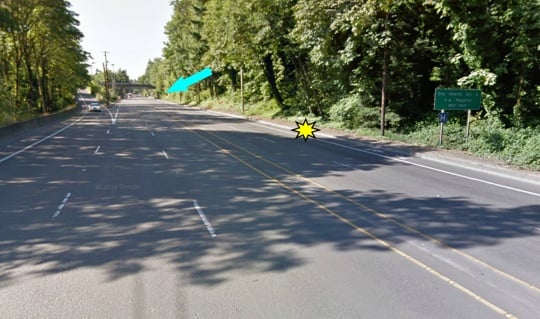
“The reality is, we need cycle tracks on Barbur.”
— Rob Sadowsky, Bicycle Transportation Alliance
Once again, the community is reeling from a tragic collision on one of Portland’s most well-known transportation danger zones: Barbur Blvd. As Henry Schmidt continues to recover after being hit by someone driving on Barbur at around 1:00 am Friday morning, advocates have begun to mobilize and discuss (once again) their next moves.
As we’ve covered for years here on the Front Page, the ODOT-controlled sections of Barbur Blvd are an absolute embarrassment to our city. Barbur is known for very high speed driving and unpleasant bicycling conditions. Back in 2010, we shared news about the formation of a grassroots “Friends of Barbur” group which was formed specifically to address major concerns about bicycle safety. In fact, our lead image for that story (below) shows the group’s digital rendering of a protected bikeway in the same general location where Henry Schmidt was hit early Friday morning.

The Friends of Barbur has remained active since then, more recently joining a chorus of advocates calling for a road diet treatment to the street that would re-allocate space and provide a wider — and safer — berth for people riding bicycles.
After Friday’s hit-and-run, even the Bicycle Transportation Alliance (BTA) is directing stern words toward ODOT and once again renewing calls for a re-design of the road.
“We’ve tried to make this clear,” BTA Executive Director Rob Sadowsky shared in an interview with us today, “We need both an immediate and a long-term solution… This tragedy is just further evidence that we need separated facilities.”
“Nothing we can do will ever ban crashes. We had a horrible crash with a guy who was walking on the side of a road with his bike at night. No effective permanent fixes will happen immediately.”
— Don Hamilton, ODOT spokesman
Sadowsky pointed out that there’s no adequate alternate route off of Barbur for people to ride on. “Unlike NE Broadway for instance, there’s not a neighborhood greenway a few blocks away. That’s what raises this issue to a crisis level is that Barbur is one of only a few places you can ride from southwest to downtown.”
Sadowsky says Barbur is a perfect location to re-purpose the existing space in a way that makes bicycle travel safer and more comfortable. “We just see this as another example of why we need a real road diet there. We need real traffic calming.” As stated in their recently released Blueprint report, “Repurposing underused motor vehicle lanes at the northern end of Barbur will allow for safe, protected bike lanes.”
But so far, ODOT hasn’t taken concrete steps toward any major changes to Barbur Blvd other than to direct our attention to the SW Corridor planning process being undertaken by Metro. This process includes a Barbur Blvd road diet as one of dozens of short and long-term changes to the corridor that might come with a future high capacity transit line.
While deferring to the SW Corridor Plan seems like a punt, ODOT spokesman Don Hamilton says that remains the best avenue for change. “I know you have some cynicism on the SW Corridor Plan,” Hamilton shared with me via phone today, “But from what I understand there is pretty strong bike influence devising this plan.” Hamilton pointed out that there are short-term fixes being considered in that plan, some of which could include a road diet on Barbur.
Hamilton said changes to Barbur are “certainly needed,” given Friday’s tragedy. “It’s horrific,” he said. When pressed on why ODOT doesn’t step out of the SW Corridor process and make Barbur changes a higher, immediate priority, Hamilton said, “Nothing we can do will ever ban crashes. We had a horrible crash with a guy who was walking on the side of a road with his bike at night. No effective permanent fixes will happen immediately.” Hamilton said it’s a complicated situation that has to be carefully examined, that funding must be found, and ODOT must study how they fit together “all the different components of the operation of a safe road.”
When asked if ODOT feels Barbur is a safety problem, Hamilton said, “It’s definitely an area of concern, that’s why its being looked at now.”
Less than one mile south of where Schmidt was hit, ODOT is investing $5 million to rehabilitate two bridges on Barbur. While many thought that project might be a good trigger for significant bike safety improvements, ODOT plans nothing more than flashing lights and “Bikes on Bridge” signs.
As for claims that ODOT isn’t doing anything to address the safety concerns, Hamilton says, “We’re not doing nothing. We’re going to try and make something happen on this that will result in some significant improvements we hope.”
We’re not sure that will be convincing enough for advocates like Sadowsky to cool their jets. He said they’re considering mobilizing activists for some sort of action around Barbur in the days/weeks to come (contact Carl Larson at carl@btaoregon.org if you’d like to be a part of it).
“The reality is,” Sadowsky said, “we need cycle tracks on Barbur and the only way to do that is a road diet, or carve out additional space for a side path. And we don’t want to wait 15 years for a new light rail line before it happens.”
— For more on Schmidt and the people who stopped to help him, read and watch this great coverage from KATU.

